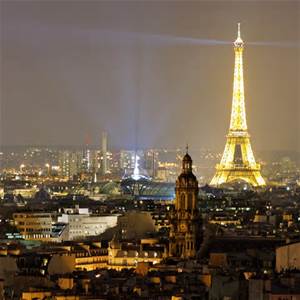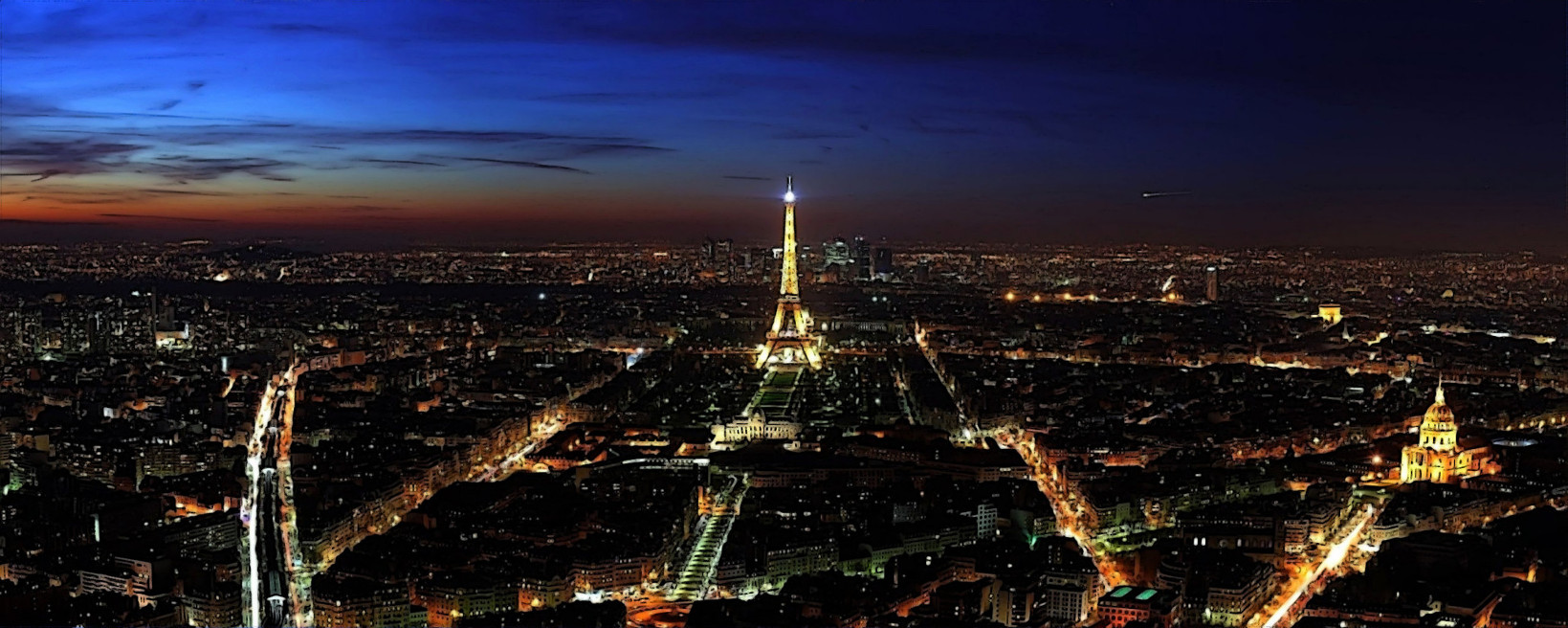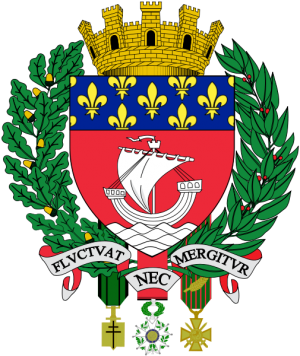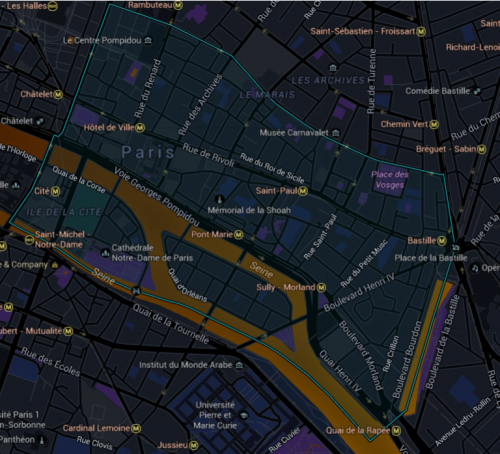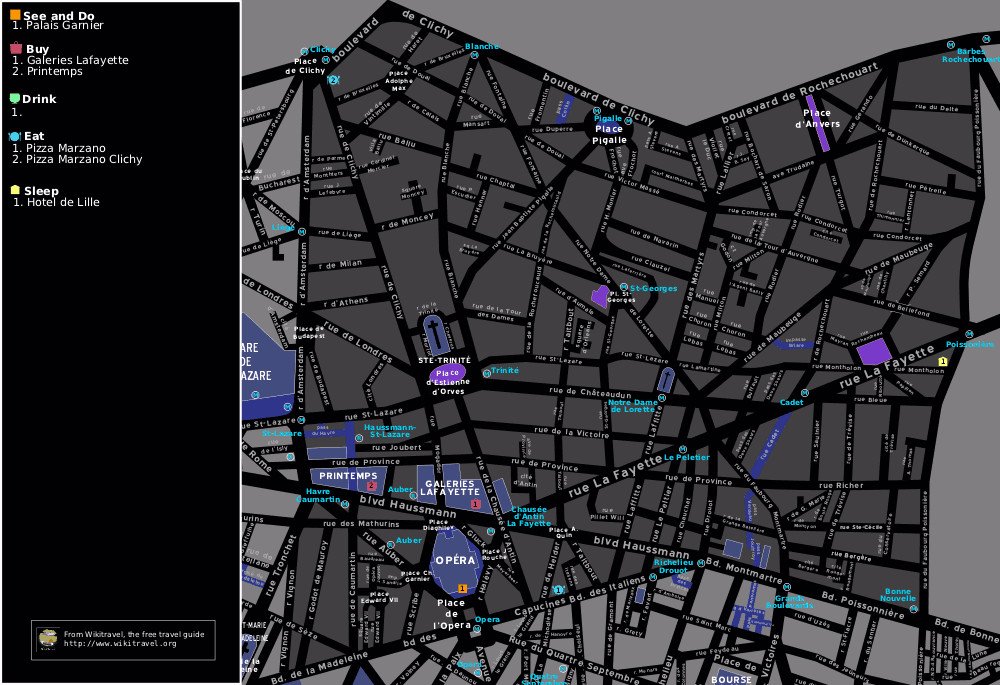Paris
- Main Page -P- France -P- New Orleans
Contents
- 1 Quote
- 2 Appearance
- 3 City Device
- 4 Climate
- 5 Calendars
- 6 Economy
- 7 Geography
- 8 History
- 9 Population
- 10 Arrondissements
- 10.1 Layout of the Parisian Arrondissements
- 10.2 1st Arrondissement
- 10.3 2nd Arrondissement
- 10.4 3rd Arrondissement
- 10.5 4th Arrondissement
- 10.6 5th Arrondissement
- 10.7 6th Arrondissement: St. Germain
- 10.8 7th Arrondissement: The Eiffel Tower
- 10.9 8th Arrondissement: Champs Elysees
- 10.10 9th Arrondissement: Opera, Pigelle
- 10.11 10th Arrondissement: Canal St. Martin
- 10.12 11th Arrondissement: Bastille
- 10.13 12th Arrondissement: Bercy
- 10.14 13th Arrondissement: Place De I'talie
- 10.15 14th Arrondissement: Montparnasse
- 10.16 15th Arrondissement: Parc De Exposition
- 10.17 16th Arrondissement: Trocadero
- 10.18 17th Arrondissement: Palais De Congres
- 10.19 18th Arrondissement: Montmartre / Pigalle / Goutte d'Or / Quartier de La Chapelle
- 10.20 19th Arrondissement: Parc De La Villete
- 10.21 20th Arrondissement: Belleville, Lachaise
- 10.22 Below Paris
- 11 Arenas
- 12 Attractions
- 13 Bars and Clubs
- 14 Cemeteries
- 15 City Government
- 16 Citizens of the City
- 17 Crime
- 18 Cults
- 19 Current Events
- 20 Fortifications
- 21 Galleries
- 22 Holy Ground
- 23 Hospitals
- 24 Hotels & Hostels
- 25 Landmarks
- 26 Law Enforcement
- 27 Maps
- 28 Market Places
- 29 Monasteries
- 30 Monuments
- 31 Multinational Corporations
- 32 Museums
- 33 Neighborhoods
- 34 Opera Houses
- 35 Parks
- 36 Private Residences
- 37 Restaurants
- 38 Ruins
- 39 Schools
- 40 Shops
- 41 Etres Surnaturels de Paris
- 42 Theaters
- 43 Transportation
- 44 Vampires of the City
- 44.1 The Legacy of Caine: The Traditions
- 44.2 The Legacy of Villon: The Edicts
- 44.3 The Enforcers of Villon
- 44.4 Les Droits Coutumiers: The Customary Laws
- 44.5 Vampire Factions in Paris
- 44.6 Effect of the Toreador Hegemony on Status
- 44.7 The Noble Clans
- 44.8 The Low or Unwelcome Clans
- 44.9 Guests of the Parisian Court
- 44.10 Bloodlines
- 44.11 Ghouls of the City of Lights
- 44.12 The Ghosts of Paris
- 44.13 The Puppet Masters of Paris
- 44.14 Stories set within the City of Lights
- 45 Websites
Quote
In Paris, everybody wants to be an actor; nobody is content to be a spectator. -- Jean Cocteau
The "Eternal City," Paris is as central to the psyche of France as any capital city in the world. Built on the banks of the Seine, Paris is divided into twenty sections called Arrondissements. The city has hundreds of restaurants, museums, archives, theaters and quaint Bohemian-style neighborhoods haunted by artists and tinkers. Though the trend-setting capital of Toreador society, some Malkavians live here, inspiring mortals in their own bizarre fashion. The elders of Paris have both created and destroyed more artists than most other European vampires will ever meet.
Francois Villon is the Toreador Prince of Paris. He rules the "City of Lights" and his special pet interest, the fashion community, from the seat of Toreador power in the 1st Arrondissement at the Louvre. His words are absolute law with regard to art and culture, not only in Paris but throughout much of France and the "civilized" world as well. He is especially fond of beautiful women, and many famous models have given of their vitae to Paris' prince.
Yet there are those who tire of the last three centuries of Toreador rule. Brujah idealists clamor for the influence that they feel they have earned. Nosferatu see Paris as a city where their appreciation of beauty should be acknowledged. The city is also home to a number of anarchs who want to bring down the current hard-line regime by violent means. Worse, a number of Sabbat dwell in the nineteenth and twentieth Arrondissements amide the lower-class neighborhoods and old slaughterhouses. If rumor is to be believed, they have recently made a few recruits among the social elite in Paris, and it seems that the city, so superficially perfect and serene, may well crumble, eaten away with rot from within.
-- Excerpt from the Journal DXLIV of Aristotle de Laurent
Appearance
City Device
Climate
Paris has a typical Western European oceanic climate which is affected by the North Atlantic Current. The overall climate throughout the year is mild and moderately wet. Summer days are usually moderately warm and pleasant with average temperatures hovering between 15 and 25 °C (59 and 77 °F), and a fair amount of sunshine. Each year, however, there are a few days where the temperature rises above 30 °C (86 °F). Some years have even witnessed some long periods of harsh summer weather, such as the heat wave of 2003 where temperatures exceeded 30 °C (86 °F) for weeks, surged up to 39 °C (102 °F) on some days and seldom cooled down at night. More recently, the average temperature for July 2011 was 17.6 °C (63.7 °F), with an average minimum temperature of 12.9 °C (55.2 °F) and an average maximum temperature of 23.7 °C (74.7 °F).
Spring and autumn have, on average, mild days and fresh nights, but are changing and unstable. Surprisingly warm or cool weather occurs frequently in both seasons. In winter, sunshine is scarce; days are cold but generally above freezing with temperatures around 7 °C (45 °F). Light night frosts are however quite common, but the temperature will dip below −5 °C (23 °F) for only a few days a year. Snowfall is uncommon, but the city sometimes sees light snow or flurries with or without accumulation.
Rain falls throughout the year. Average annual precipitation is 652 mm (25.7 in) with light rainfall fairly distributed throughout the year. The highest recorded temperature is 40.4 °C (104.7 °F) on July 28, 1948, and the lowest is a −23.9 °C (−11.0 °F) on December 10, 1879.
Calendars
Economy
The Paris Region is France's premier centre of economic activity, and with a 2011 GDP of €607 billion (US$845 billion), it is not only the wealthiest area of France, but has one of the highest GDPs in the world, after Tokyo, New York, Los Angeles, Seoul and London, making it an engine of the global economy. Were it a country, it would rank as the seventeenth-largest economy in the world, larger than the Turkish and Dutch economies and almost as large as Indonesia's. While its population accounted for 18.8 percent of the total population of metropolitan France in 2011, its GDP accounted for 31.0 per cent of metropolitan France's GDP. Wealth is heavily concentrated in the western suburbs of Paris, notably Neuilly-sur-Seine, one of the wealthiest areas of France. This mirrors a sharp political divide, with political conservatism being much more common towards the western edge, whilst the political spectrum lies more to the left in the east.
The Parisian economy has been gradually shifting towards high-value-added service industries (finance, IT services, etc.) and high-tech manufacturing (electronics, optics, aerospace, etc.). However, in the 2009 European Green City Index, Paris was still listed as the second most "green" large city in Europe, after Berlin. The Paris region's most intense economic activity through the central Hauts-de-Seine département and suburban La Défense business district places Paris' economic centre to the west of the city, in a triangle between the Opéra Garnier, La Défense and the Val de Seine. While the Paris economy is largely dominated by services, it remains an important manufacturing powerhouse of Europe, especially in industrial sectors such as automobiles, aeronautics, and electronics. The Paris Region hosts the headquarters of 30 of the Fortune Global 500 companies.
The 1999 census indicated that, of the 5,089,170 persons employed in the Paris urban area, 16.5 per cent worked in business services; 13.0 per cent in commerce (retail and wholesale trade); 12.3 per cent in manufacturing; 10.0 per cent in public administrations and defence; 8.7 per cent in health services; 8.2 per cent in Transport and communications; 6.6 per cent in education, and the remaining 24.7 per cent in many other economic sectors. In the manufacturing sector, the largest employers were the electronic and electrical industry (17.9 per cent of the total manufacturing workforce in 1999) and the publishing and printing industry (14.0 per cent of the total manufacturing workforce), with the remaining 68.1 per cent of the manufacturing workforce distributed among many other industries. Tourism and tourist related services employ 6.2 per cent of Paris' workforce, and 3.6 per cent of all workers within the Paris Region. Unemployment in the Paris "immigrant ghettos" ranges from 20 to 40 per cent, according to varying sources.
Paris receives around 28 million tourists per year, of which 17 million are foreign visitors, which makes the city and its region the world's leading tourism destination, housing four UNESCO World Heritage Sites. Its museums and monuments are among its highest-esteemed attractions; tourism has motivated both the city and national governments to create new ones. The city's most prized museum, the Louvre, welcomes over eight million visitors a year, being by far the world's most-visited art museum. The city's cathedrals are another main attraction: Notre Dame de Paris and the Basilique du Sacré-Coeur receive 12 million and eight million visitors, respectively. The Eiffel Tower, by far Paris' most famous monument, receives on average over six million visitors per year and has received more than 200 million since its construction. Disneyland Paris is a major tourist attraction for visitors to not only Paris but also the rest of Europe, with 14.5 million visitors in 2007. Much of Paris' hotel, restaurant and night entertainment trades have become heavily dependent on tourism.
Geography
Paris is located in northern central France. By road it is 450 kilometres (280 mi) south-east of London, 287 kilometres (178 mi) south of Calais, 305 kilometres (190 mi) south-west of Brussels, 774 kilometres (481 mi) north of Marseilles, 385 kilometres (239 mi) north-east of Nantes, and 135 kilometres (84 mi) south-east of Rouen. Paris is located in the north-bending arc of the river Seine, spread widely on both banks of the river, and includes two inhabited islands, the Île Saint-Louis and the larger Île de la Cité, which forms the oldest part of the city. The river’s mouth on the English Channel (La Manche) is about 233 mi (375 km) downstream of the city. Overall, the city is relatively flat, and the lowest point is 35 m (115 ft) above sea level. Paris has several prominent hills, of which the highest is Montmartre at 130 m (427 ft). Montmartre gained its name from the martyrdom of Saint Denis, first bishop of Paris atop the "Mons Martyrum" (Martyr's mound) in 250 A.D.
Excluding the outlying parks of Bois de Boulogne and Bois de Vincennes, Paris occupies an oval measuring about 87 km2 (34 sq mi) in area, enclosed by the 35 km (22 mi) ring road, the Boulevard Périphérique. The city's last major annexation of outlying territories in 1860 not only gave it its modern form but also created the twenty clockwise-spiralling arrondissements (municipal boroughs). From the 1860 area of 78 km2 (30 sq mi), the city limits were expanded marginally to 86.9 km2 (33.6 sq mi) in the 1920s. In 1929, the Bois de Boulogne and Bois de Vincennes forest parks were officially annexed to the city, bringing its area to about 105 km2 (41 sq mi). The metropolitan area of the city is 2,300 km2 (890 sq mi).
History
Population
- -- City (2,868,711) - 2030 census
- -- Urban (12,968,643) - 2030 census
- -- Metro Area (16,044,321) - 2030 census
Arrondissements
Introduction: The city of Paris is divided into twenty arrondissements municipaux, administrative districts, more simply referred to as arrondissements. These are not to be confused with departmental arrondissements, which subdivide the 101 French départements. The word "arrondissement", when applied to Paris, refers almost always to the municipal arrondissements listed below. The number of the arrondissement is indicated by the last two digits in most Parisian postal codes (75001 up to 75020).
Layout of the Parisian Arrondissements
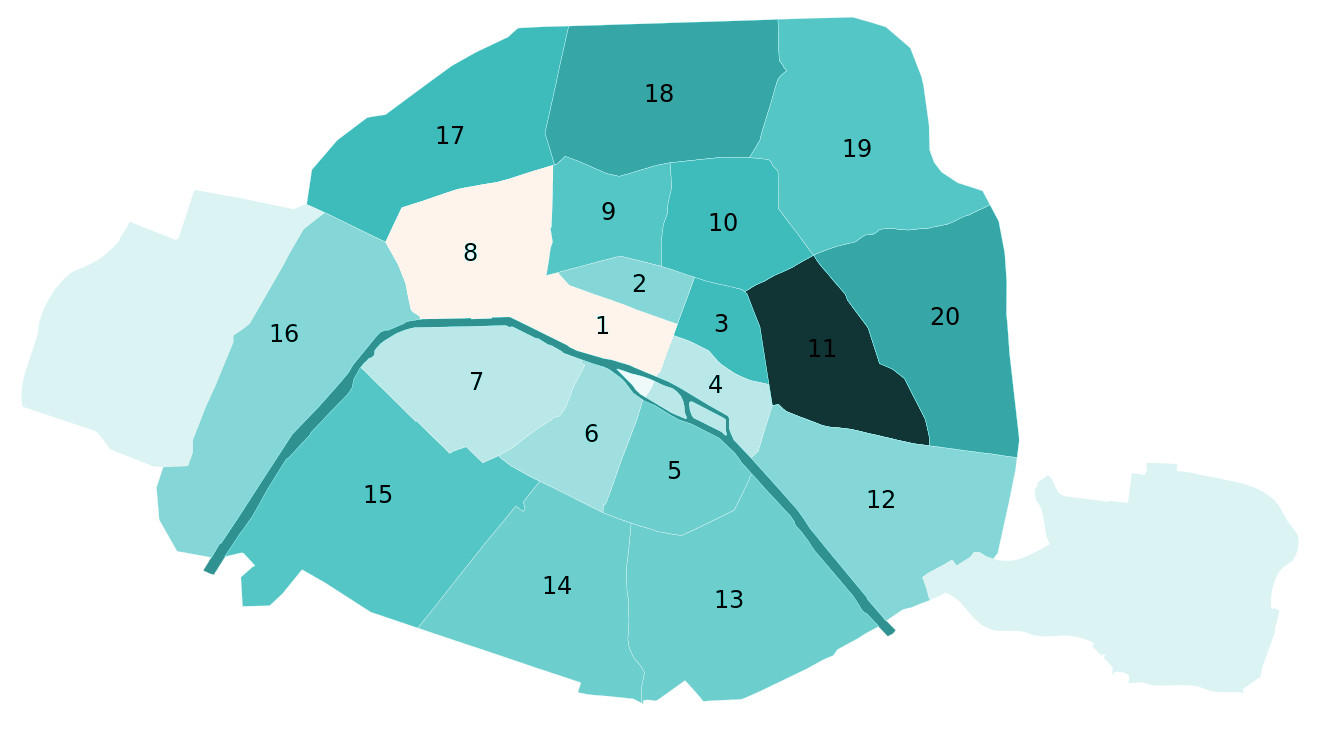
The twenty arrondissements are arranged in the form of a clockwise spiral (often likened to a snail shell),[1] starting from the middle of the city, with the first on the Right Bank (north bank) of the Seine. The French cities of Lyon and Marseille have, more recently, also been subdivided into arrondissements.
In French, notably on street signs, the number is often given in Roman numerals. For example, the Eiffel Tower belongs to the VIIe arrondissement while Gare de l'Est is in the Xe arrondissement.
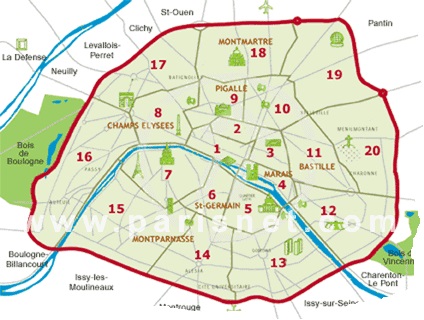
http://en.wikipedia.org/wiki/Arrondissements_of_Paris
1st Arrondissement
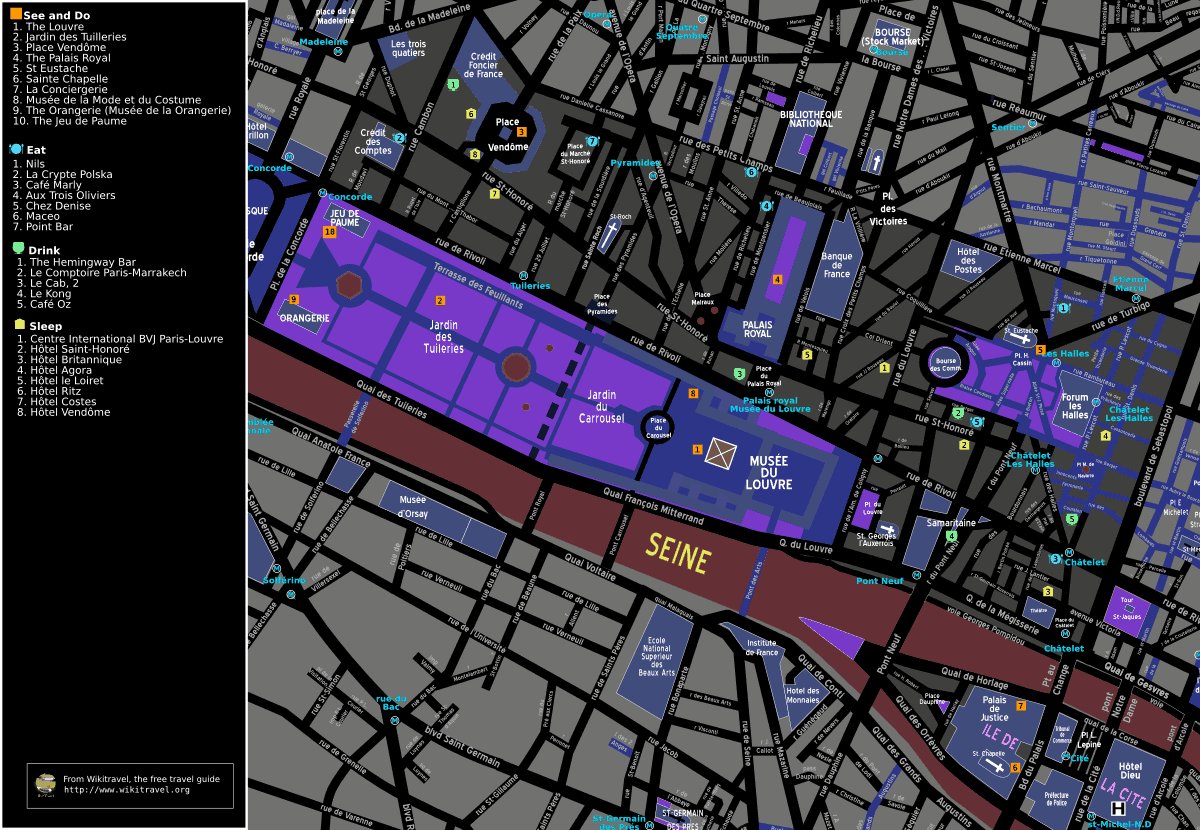
Introduction: The 1st arrondissement forms much of the historic centre of Paris. Situated principally on the right bank of the River Seine, it also includes the west end of the Île de la Cité. The arrondissement is one of the oldest in Paris, the Île de la Cité having been the heart of the city of Lutetia, conquered by the Romans in 52 BC, while some parts on the right bank (including Les Halles) date back to the early Middle Ages.
It is the least populated of the city's arrondissements and one of the smallest by area, a significant part of which is occupied by the Louvre Museum and the Tuileries Gardens. Much of the remainder of the arrondissement is dedicated to business and administration.
- -- Arc de Triomphe de l'Étoile: is one of the most famous monuments in Paris. It stands in the centre of the Place Charles de Gaulle (originally named Place de l'Étoile), at the western end of the Champs-Élysées. It should not be confused with a smaller arch, the Arc de Triomphe du Carrousel, which stands west of the Louvre. The Arc de Triomphe honors those who fought and died for France in the French Revolutionary and the Napoleonic Wars, with the names of all French victories and generals inscribed on its inner and outer surfaces. Beneath its vault lies the Tomb of the Unknown Soldier from World War I.
- -- Avenue des Champs-Élysées: is a street in Paris with cinemas, cafés, luxury specialty shops and clipped horse-chestnut trees, the Champs-Élysées is arguably one of the world's most famous streets, and is one of the most expensive strips of real estate in the world. Several French monuments are also on the street, including the Arc de Triomphe and the Place de la Concorde. The name is French for Elysian Fields, the place of the blessed dead in Greek mythology. According to a much used description, the Champs-Élysées is "la plus belle avenue du monde" ("the most beautiful avenue in the world"). -- {Elysium}
- -- Châtelet-Les-Halles: A central underground station of Paris's express commuter rail system, the RER, that lies beneath the Forum des Halles shopping precinct.
- -- Comédie-Française: or Théâtre-Français is one of the few state theaters in France. It is the only state theater to have its own troupe of actors. The company's primary venue is the Salle Richelieu. The or Théâtre-Français is one of the few state theaters in France. It is the only state theater to have its own troupe of actors. The company's primary venue is the Salle Richelieu. The theater is part of the Palais-Royal complex and located at 2 rue de Richelieu on the Place André-Malraux in the 1st arrondissement.
- -- Galerie nationale du Jeu de Paume: is a museum of contemporary art in the north corner (west side) of the Tuileries Gardens next to the Place de la Concorde in Paris.
- -- Île de la Cité: is one of two remaining natural islands in the Seine within the city of Paris (the other being the Île Saint-Louis). It is the center of Paris and the location where the medieval city was re-founded.
- -- La Conciergerie: is a former royal palace and prison in Paris, located on the west of the Île de la Cité (literally island of the city). It is part of the larger complex known as the Palais de Justice, which is still used for judicial purposes. Hundreds of prisoners during the French Revolution were taken from La Conciergerie to be executed on the guillotine at a number of locations around Paris.
- -- The Louvre: is one of the world's largest museums and a historic monument in Paris, France. A central landmark of the city, it is located on the Right Bank of the Seine in the 1st arrondissement.
- -- Forum des Halles: An underground modern shopping precinct whose open air center area is below street level, like a sunken garden, and contains sculptures, fountains, and mosaics.
- -- Musée du Louvre: (The Louvre) -- is one of the world's largest museums and a historic monument. -- {Elysium}
- -- Palais de Justice de Paris: is located upon the Île de la Cité in central Paris. Thee palace is built on the site of the former royal palace of Saint Louis, of which the Sainte Chapelle remains. Thus the justice of the state has been dispensed at this site since medieval times. From the sixteenth century to the French Revolution this was the seat of the Parlement de Paris. The Palais also contains the ancient structure of the Conciergerie, a former prison, now a museum, where Marie Antoinette was imprisoned before being executed on the guillotine.
- -- Palais-Royal de Paris: was originally called the Palais-Cardinal, the palace was the personal residence of Cardinal Richelieu. The architect Jacques Lemercier began his design in 1629; construction commenced in 1633 and was completed in 1639. Upon Richelieu's death in 1642 the palace became the property of the King and acquired the new name Palais-Royal.
- -- Place Charles de Gaulle: historically known as the Place de l'Étoile. It is a large road junction in Paris, the meeting point of twelve straight avenues (hence its historic name, which translates as "Square of the Star") including the Champs-Élysées. It was renamed in 1970 following the death of General and President Charles de Gaulle. It is still often referred to by its original name, and the nearby metro station retains the designation Charles de Gaulle - Étoile.
- -- Place du Châtelet: is a public square in Paris, on the right bank of the river Seine, on the borderline between the 1st and 4th arrondissements. It lies at the north end of the Pont au Change, a bridge that connects the Île de la Cité, near the Palais de Justice and the Conciergerie, to the right bank. The name "Châtelet" refers to the stronghold, the Grand Châtelet, that guarded the northern end of the Pont au Change, containing the offices of the prévôt de Paris and a number of prisons, until it was demolished in 1802-10.
- -- Place Dauphine: is a public square located near the western end of the Île de la Cité in the first arrondissement of Paris. It was initiated by Henry IV in 1607, the second of his projects for public squares in Paris, the first being the Place Royale (now the Place des Vosges). He named it for his son, the Dauphin of France and future Louis XIII, who had been born in 1601. From the "square", actually triangular in shape, one can access the middle of the Pont Neuf, a bridge which connects the left and right banks of the Seine by passing over the Île de la Cité. A street called, since 1948, Rue Henri-Robert, forty meters long, connects the Place Dauphine and the bridge. Where they meet, there are two other named places, the Place du Pont Neuf and the Square du Vert Galent.
- -- Place des Pyramides: is a public square in the 1st arrondissement; it is located in the middle of the Rue de Rivoli, at its intersection with the Rue des Pyramides and Avenue du General Lemonnier, at the western end of the Tuileries Garden. The square was named for the street, Rue des Pyramides, and the street was named for the Battle of the Pyramids, a Napoleonic victory achieved in Egypt in 1798.
- -- Place des Victoires: is a circular place, located a short distance northeast from the Palais Royal and straddling the border between the 1st and the 2nd arrondissements. The Place des Victoires is at the confluence of six streets: Rue de la Feuillade, Rue Vide Gousset, Rue d'Aboukir, Rue Étienne Marcel, Rue Croix des Petits Champs, and Rue Catinat.
- -- Théâtre du Châtelet: is a theatre and opera house, located in the place du Châtelet in the 1st arrondissement of Paris.
- -- Théâtre du Palais-Royal: is a 950-seat Parisian theatre at 38 rue de Montpensier, located at the northwest corner of the Palais-Royal in the Galerie de Montpensier at its intersection with the Galerie de Beaujolais.
- -- Tuileries Garden: is a public garden located between the Louvre Museum and the Place de la Concorde in the 1st arrondissement of Paris. Created by Catherine de Medicis as the garden of the Tuileries Palace in 1564, it was eventually opened to the public in 1667, and became a public park after the French Revolution. In the 19th and 20th century, it was the place where Parisians celebrated, met, promenaded, and relaxed. -- {Elysium}
2nd Arrondissement
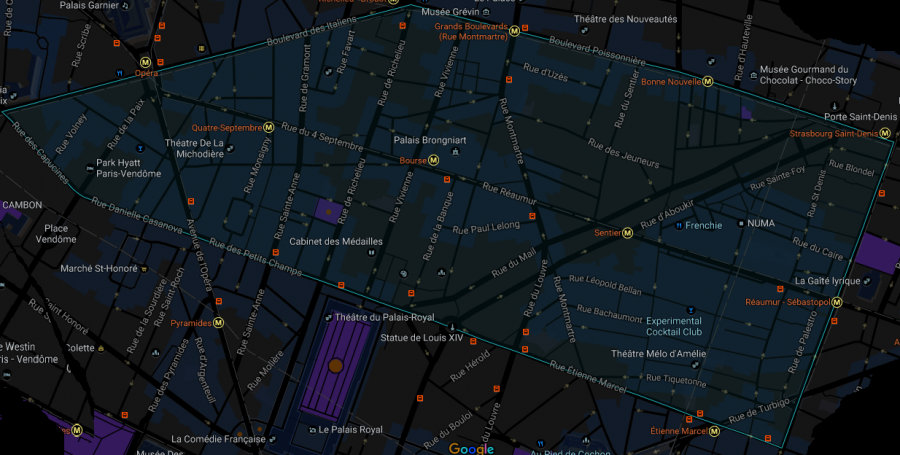
Introduction: The 2nd arrondissement (2e arrondissement) is one of the 20 arrondissements of Paris, the capital city of France. Located on the right bank of the River Seine, the 2nd arrondissement, together with the adjacent 8th and 9th arrondissements, hosts an important business district, centred on the Paris Opéra, which houses the city's most dense concentration of business activities. The arondissement contains the former Paris Bourse (stock exchange) and a large number of banking headquarters, as well as a textile district, known as the Sentier, and the Opéra-Comique concert hall.
The 2nd arrondissement is also the home of most of Paris's surviving 19th-century glazed commercial arcades. At the beginning of the 19th century most of the streets of Paris were dark and muddy and lacked sidewalks. A few entrepreneurs copied the success of the Passage des Panoramas and its well-lit, dry and paved pedestrian passageways. By the middle of the 19th century there were about two dozen of these commercial malls, but most of them disappeared as the Paris authorities paved the main streets, added sidewalks and gas street lighting. The commercial survivors are – in addition to the Passage des Panoramas – the Galerie Vivienne, the Passage Choiseul, the Galerie Colbert, the Passage des Princes, the Passage du Grand Cerf, the Passage du Caire, the Passage Lemoine, the Passage Jouffroy, the Passage Basfour, the Passage du Bourg-L'abbé, and the Passage du Ponceau.
- -- Passage du Caire -- The Passage du Caire is one of roughly a dozen, surviving, glass-covered commercial arcades. According to some prominent historians, the Passage du Caire is not only the oldest of Paris' passages couverts, having been established a year before the still famous Passage des Panoramas, but the narrowest (sometimes no more than a meter wide) and most certainly the longest at three hundred and seventy meters end-to-end (1110 feet).
- -- Passage Choiseul -- A considerably more down-to-earth gallery, the passage mainly serves traders on their way to the Bourse, with the same class of shops that one might find in a pedestrian tunnel in New York or Chicago: a shoeshine stand, a newsstand, and little almost-but-not-quite fast-food restaurants.
- -- Passage des Panoramas -- This isthe oldest of the covered passages of Paris, located in the 2nd arrondissement of Paris between the Montmartre boulevard to the North and Saint-Marc street to the south. It is one of the earliest venues of the Parisian philatelic trade, and it was one of the first covered commercial passageways in Europe. Bazaars and souks in the Orient had roofed commercial passageways centuries earlier but the Passage de Panoramas innovated in having glazed roofing and, later on, in 1817, gas lights for illumination. It was an ancestor of the city gallerias of the 19th century and the covered suburban and city shopping malls of the 20th century.
- -- Galerie Vivienne -- This gallery is the best preserved of the galleries and whose décor has been maintained in authentic colors from the era. It's really the mosaic floor which is the star of the show. The shops are distinctly upscale, and all about conspicuous consumption: a wine seller, a tea shop, and a dealer in antique books are among the highlights.
- -- L'Obs -- A weekly French news magazine. Based in the 2nd arrondissement of Paris.
- -- Head Offices Of ''Bourbon'' --
- -- Bibliothèque nationale de France -- The Bibliothèque nationale de France (BnF; French: [bi.bli.jɔ.tɛk na.sjɔ.nal də fʁɑ̃s]) is the National Library of France, located in Paris. It is intended to be the repository of all that is published in France.
- -- Théâtre national de l'Opéra-Comique (National Opéra Comic Theatre) --
- -- Place des Victoires. Beautiful round 'square' with an equestrian statue of King Louis the XIVth and matching XVIIth century building. edit
- -- Notre Dame des Victoires. XVIIth century church.
- -- La Tour Jean-sans-Peur -- 20 rue Étienne-Marcel (Métro: Étienne-Marcel). April-October wed-sun 1:30pm-6pm. One of the last remnants of medieval Paris outside of the 4th, this tower was once part of a castle called l'hôtel de Bourgogne
- -- Rue Montorgueil pedestrian area. Rue Montorgueil is like a scene from a movie. Closed to traffic, the street is a food-lovers delight, with cafes, bars and all types of fresh produce for sale in the open air. On weekends it stays open until midnight.
3rd Arrondissement
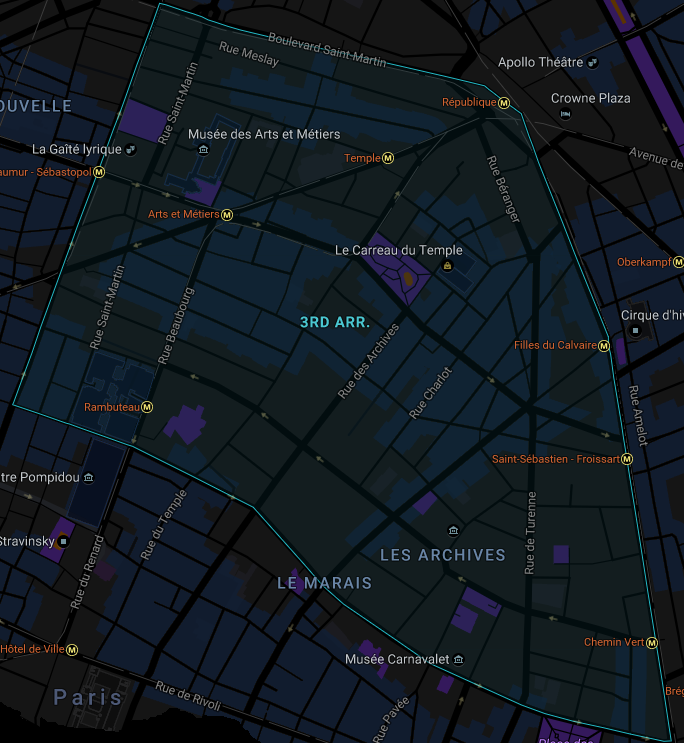
The 3rd arrondissement of Paris, situated on the right bank of the River Seine, is the smallest in area after the 2nd arrondissement. The arrondissement contains the northern, quieter part of the medieval district of Le Marais (while the 4th arrondissement contains Le Marais' more lively southern part, notably including the gay district of Paris). The oldest surviving private house of Paris, built in 1407, is to be found in the 3rd arrondissement, along the rue de Montmorency.
The ancient Jewish quarter, the Pletzel (little place in Yiddish) which dates from the 13th century begins in the eastern part of the 3rd arrondissement and extends into the 4th. It is home to the Musée d'art et d'histoire du judaïsme and the Agoudas Hakehilos synagogue designed by the architect Guimard. Although trendy boutiques are now taking up many of the storefronts, there are still landmark stores selling traditional Jewish foods.
A small but slowly expanding Chinatown inhabited by immigrants from Wenzhou centers on the rue au Maire, near the Conservatoire National des Arts et Métiers housed in the medieval priory of Saint-Martin-des-Champs.
- -- Musée Picasso :
- -- Musée national des Arts et Métiers :
- -- Musée d'Art et d'Histoire du Judaïsme :
- -- Musée de la Serrure :
- -- Musée Cognacq-Jay :
- -- Musée Carnavalet :
- -- Les Archives Nationales :
- -- Les Enfants Rouge : Food & Drink
- -- Andy Wahloo :
- -- La Villa Kéops :
4th Arrondissement
[[]]
Introduction: The 4th arrondissement contains the Renaissance-era Paris City Hall. It also contains the Renaissance square of Place des Vosges, the overtly modern Pompidou Centre and the lively southern part of the medieval district of Le Marais, which today is known for being the gay district of Paris (while the more quiet northern part of Le Marais is contained inside the 3rd arrondissement). The eastern parts of the Île de la Cité (including Notre-Dame de Paris) as well as the Île Saint-Louis are also included within the 4th arrondissement.
- -- Notre Dame Cathedral :
- -- Hotel de Ville :
- -- Tour St. Jaques :
- -- La Bastille :
- -- Memorial de la Shoah :
- -- Centre Georges Pompidou :
- -- :
- -- :
- -- :
- -- :
5th Arrondissement
[[]]
Introduction: Known as the Latin Quarter, this fabled neighborhood takes its name from the Sorbonne, where Latin was the common tongue for all students during the Middle Ages. The neighborhood has the feel of a small village and students mix freely with professionals in its winding streets. The rue Mouffetard is a primary artery where shops, international restaurants and student bars and cafés are found.
- -- :
- -- :
- -- :
- -- :
- -- :
- -- :
- -- :
- -- :
- -- :
- -- :
6th Arrondissement: St. Germain
[[]]
Introduction: Once the hangout for bohemians and intellectuals, this district has undergone gentrification and is now one of the most expensive neighborhoods in Paris. Trendy boutiques, art galleries, and restaurants can be found throughout this district.
- -- Abbey of Saint-Germain-des-Prés:
- -- :
- -- The Bohemian Escape:
- -- :
- -- :
- -- :
- -- :
- -- :
- -- :
- -- Shakespeare and Company: English language bookstore established in 1919.
7th Arrondissement: The Eiffel Tower
[[]]
Introduction: The Eiffel Tower, the Musée d'Orsay, the Rodin Museum and the market street, Rue Cler can be found here. This very wealthy district is also known for being the home of foreign embassies and many international residents.
- -- The American Library in Paris:
- -- :
- -- :
- -- :
- -- :
- -- Quai d'Orsay: The Quai d’Orsay is a quay in the 7th arrondissement of Paris, part of the left bank of the Seine, and the name of the street along it. The Quai becomes the Quai Anatole-France (fr) east of the Palais Bourbon, and the Quai Branly west of the Pont de l'Alma.
- -- :
- -- :
- -- :
- -- :
8th Arrondissement: Champs Elysees
[[]]
Introduction: This upscale neighborhood is in fact quite diverse. The area around the famous Avenue des Champs-Elysèes has lots of shopping and lots of tourists, while in the area to the East, between the Champs-Elysees and Place de la Madeleine, you'll find a mixture of 19th century buildings intermingled with businesses. This area is in many ways similar to parts of the 16th, but is generally less pretentious.
- -- Avenue des Champs-Elysèes --
- -- :
- -- :
- -- :
- -- :
- -- :
- -- :
- -- :
- -- :
- -- :
9th Arrondissement: Opera, Pigelle
Introduction
A diverse residential area popular among an artistic crowd. This Southern portion is similar to the 2nd arrondissement, with a mix of residential and business buildings. The Paris Opera is located here as well as Les Grands Magasins (Galeries Lafayette and Printemps). Further North is Pigalle, home of the famous Moulin Rouge and the fading Red Light district.
Location within Paris
District Layout
Sites of Interest
- -- Bibliothèque-Musée de l'Opéra National de Paris --
- -- Folies Bergère -- at 32, rue Richer
- -- Fondation Dosne-Thiers --
- -- Galeries Lafayette -- Located at 40, boulevard Haussmann -- (the flagship store)
- -- Hôtel Drouot -- A auction house.
- -- Kagoshima Paris --
- -- Palais Garnier -- The Opera House of Paris. {Now used primarily for the purposes of ballet.}
- -- Paris Olympia --
- -- Printemps -- A department store. (the flagship store)
- -- Musée de la Franc-Maçonnerie --
- -- Musée Grévin -- The Musée Grévin is a wax museum in Paris located on the Grands Boulevards in the 9th arrondissement on the right bank of the Seine, at 10, Boulevard Montmartre. It is open daily; an admission fee is charged.
- -- Musée Gustave Moreau -- Located at 14, rue de la Rochefoucauld.
- -- Musée du Parfum --
- -- Musée de la Vie Romantique --
- -- Quartier Pigalle --
Websites
https://en.wikipedia.org/wiki/9th_arrondissement_of_Paris
10th Arrondissement: Canal St. Martin
[[]]
Introduction: The 10th arrondissement of Paris centers on the Canal St. Martin and the restaurants and cafés which line its banks. Part sleepy faubourg — as suburbs were called in 18th century Paris — and part industrial center, the 10th arrondissement has lately enjoyed the benefits of both the booming nightlife scene in the neighboring 11th, as well as the Parisien cycling and roller-blading boom. The streets lining the canal become car-free for the later half of the day each Saturday, and all day on Sundays for your cycling and strolling pleasure.
Canal St. Martin
There is another, more bustling side to the cosmopolitan 10th, however, as the location of two primary entry / exit points for the city, in the form of the two great train stations Gare du Nord and Gare de l'Est.
One final focus to the 10th is the historic Place de la République in the far south of the arrondissement, its many bars, restaurants and cafés. The two great train stations in Paris are here, the Gare de l'Est and the Gare du Nord. This multi-cultural neighborhood also contains a bohemian element. The cafes and restaurants along the Canal Saint-Martin make it a popular destination for both Parisians and tourists.
- -- Gare de l'Est
- -- Gare du Nord
- -- Promenade Canal St. Martin -- Enjoy a leisurely stroll along the water's edge while viewing amazing sunsets over the canal. Linger over a coffee and tuck into a pastry while feeling that you are experiencing the true Paris.
- -- Musee de l'Eventail 2 Boulevard de Strasbourg. Exhibits a collection of more than 400 fans from the 18th century to the present day.
- -- Palais des Glaces 37 Rue du Faubourg-du-Temple. Grand palace with two theatres, the Palais des Glaces (Palace of Mirrors) features two shows, often two comics, simultaneously, and sometimes shows for children.
- -- Hospital Saint-Louis
- -- Canal St. Martin
- -- :
- -- :
- -- :
- -- :
- -- :
11th Arrondissement: Bastille
[[]]
Introduction: Situated on the Right Bank of the River Seine, the 11th is one of the most densely populated urban districts not just of Paris but of any European city.
The eleventh arrondissement is a varied and engaging area. To the west lies the Place de la République, which is linked to the Place de la Bastille, in the east, by the sweeping, tree-lined Boulevard Richard-Lenoir, with its large markets and children's parks. The Place de la Bastille and the rue du Faubourg St Antoine are full of fashionable cafés, restaurants, and nightlife, and they also contain a range of boutiques and galleries. The Oberkampf district to the north is another popular area for nightlife. The east is more residential, with more wholesale commerce, while the areas around the Boulevard Voltaire and the Avenue Parmentier are livelier crossroads for the local community. In recent years this district has emerged as one of the trendiest regions of Paris. Place de la Bastille and the New Opera are found here. This is a primarily residential district popular among artists. It’s well known for its nightlife which is centered around the Rue de la Roquette and the Rue Oberkampf.
- -- : Bataclan (theatre)
- -- :ESCP Europe Paris Campus
- -- :
- -- :
- -- :
- -- :
- -- :
- -- :
- -- :
- -- :
12th Arrondissement: Bercy
[[]]
Introduction: Situated on the right bank of the River Seine, the district has been significantly reorganized in recent decades, especially in the areas of Cour Saint-Émilion and Bercy, which now contain the French Ministry of Finances and the Bercy arena.
The 12th arrondissement contains the Opéra de la Bastille, the second largest opera house in Paris. It was inaugurated in 1989, on the 200th anniversary of the storming of the Bastille. The Bois de Vincennes is also located in this arrondissement. A residential neighborhood bordered on the east by the Bois de Vincennes. The Promenade Plantée, an elevated greenbelt that stretches for almost 3 miles from Place de la Bastille and the indoor arena, Palais Omnisports de Bercy are also located here.
- -- Place de la Bastille (shared by the 4th, 11th and 12th arrondissements)
- -- Opéra Bastille:
- -- Bois de Vincennes :
- -- Jardin du Bassin de l'Arsenal :
- -- Cimetière de Picpus :
- -- Faubourg Saint-Antoine:
- -- Musée des Arts Forains :
- -- Palais de la Porte Dorée (Cité nationale de l'histoire de l'immigration) :
- -- Palais Omnisports de Paris-Bercy :
- -- Parc de Bercy :
- -- Paris Zoological Park (also known as Zoo de Vincennes) :
- -- Promenade plantée :
- -- Viaduc des arts :
13th Arrondissement: Place De I'talie
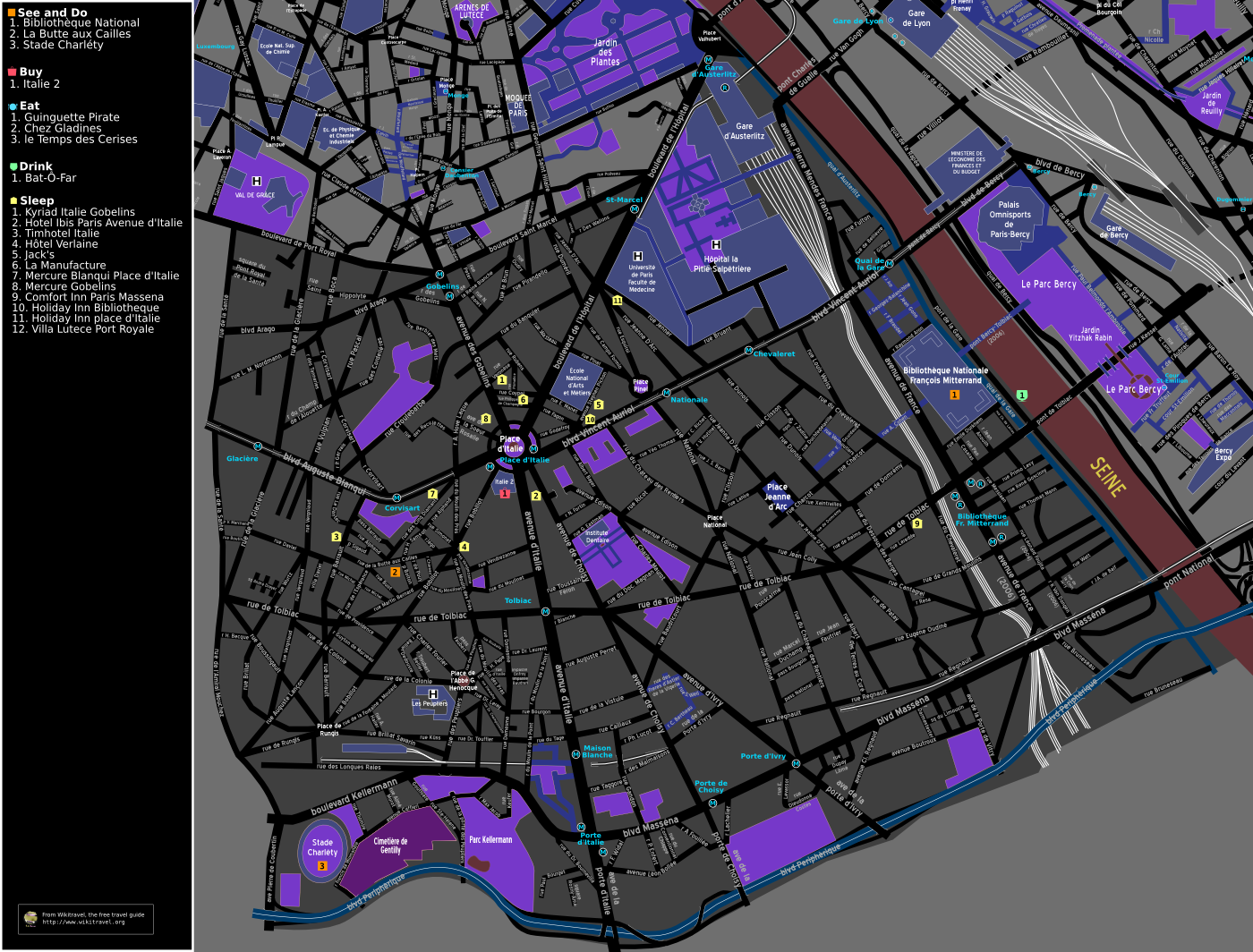
Introduction: A multi-cultural residential neighborhood which includes Paris' Chinatown and the ultra-modern Bibliothèque François Mitterand. The modernist Place d’Italie is the site of one of the most ambitious French urban renewal projects and the Butte aux Cailles neighborhood with its cobblestone streets and numerous restaurants, cafes and nightlife, preserves a village-like atmosphere within Paris.
- -- Quartier Asiatique (Asian Quarter) -- also called Triangle de Choisy or Petite Asie, is the largest commercial and cultural center for the Asian community of Paris. It is located in the southeast of the 13th arrondissement in an area that contains many high-rise apartment buildings. Despite its status as a "Chinatown", the neighborhood also contains significant Vietnamese, Laotian and Cambodian populations.
- -- Maison de Tolbiac -- Rundown theater
- -- Bibliothèque nationale de France
- -- Paris Diderot University
- -- Paris Rive Gauche
- -- Pitié-Salpêtrière Hospital
- -- Butte-aux-Cailles -- Quail Hill (neighborhood)
- -- Gare d'Austerlitz -- Austerlitz Station is one of the six large terminus railway stations in Paris. It is situated on the left bank of the Seine in the southeastern part of the city, in the 13th arrondissement. It is the start of the Paris–Bordeaux railway; the line to Toulouse is connected to this line. Since the introduction of the TGV Atlantique — using Gare Montparnasse — Austerlitz has lost most of its long-distance southwestern services. It is used by some 30 million passengers annually, about half the number passing through Montparnasse.
- -- Gobelins Manufactory -- is a tapestry factory, which still gives tours three times a week. The factory belonged to the Gobelins family, and their name hangs on many things in the area, including the main road.
- -- Art Ludique -- Museum
- -- University of Chicago Center in Paris
- -- 6 Villa des Gobelins - residence of Hồ Chí Minh from July 1919 to July 19
- Streets and Squares of Interest
14th Arrondissement: Montparnasse
[[]]
Introduction: Montparnasse and the Cité Universitaire are found in this residential district traditionally known for its lively cafés and restaurants around the Boulevard Montparnasse.
- -- : L'Ossuaire Municipal de Paris
- -- : Cimetiery du Montparnasse
- -- : Fondation Cartier pour l'Art Contemporain
- -- : Gare Montparnasse
- -- : Michael Servetus statue
- -- : Musée Lenine
- -- : Musée Jean Moulin
- -- : Paris Observatory
- -- : La Sante Prison
- -- : Tour Montparnasse
15th Arrondissement: Parc De Exposition
[[]]
Introduction: This large primarily residential neighborhood ranges from very upscale in the area bordering the 7th arrondissement and the Seine, to relatively safe and affordable in the more outlying areas.
- -- :
- -- :
- -- :
- -- :
- -- :
- -- :
- -- :
- -- :
- -- :
- -- :
16th Arrondissement: Trocadero
[[]]
Introduction: Although it is not as exclusive as the 7th arrondissement, the 16th is widely regarded as the neighborhood for the wealthy. The areas around rue de Passy and Place Victor Hugo offer upscale shopping and the Place de Trocadéro offers a splendid view of the Eiffel Tower from its trendy cafes.
- -- :
- -- :
- -- :
- -- :
- -- :
- -- :
- -- :
- -- :
- -- :
- -- :
17th Arrondissement: Palais De Congres
[[]]
Introduction: This diverse district really contains more than one neighborhood, with the portion, in the West, near the Arc de Triomphe and Parc Monceau, being very upscale.
- -- :
- -- :
- -- :
- -- :
- -- :
- -- :
- -- :
- -- :
- -- :
- -- :
18th Arrondissement: Montmartre / Pigalle / Goutte d'Or / Quartier de La Chapelle
[[]]
Introduction: This artsy residential neighborhood situated at the top of a hill overlooking Paris has a small village feel. The view across Paris from the Sacré Coeur church is breathtaking and the nearby Place du Tertre is a popular tourist destination.
Districts within the 18th Arrondissement
- -- Montmartre --
- -- Pigalle --
- -- Goutte d'Or --
- -- Quartier de La Chapelle --
Places of Interest
- -- Basilique du Sacré-Cœur --
- -- Basilica of Sainte-Jeanne-d'Arc --
- -- Église Saint-Jean-de-Montmartre --
- -- Église Saint-Bernard de la Chapelle --
- -- Moulin Rouge --
- -- Musée d'Art Naïf - Max Fourny --
19th Arrondissement: Parc De La Villete
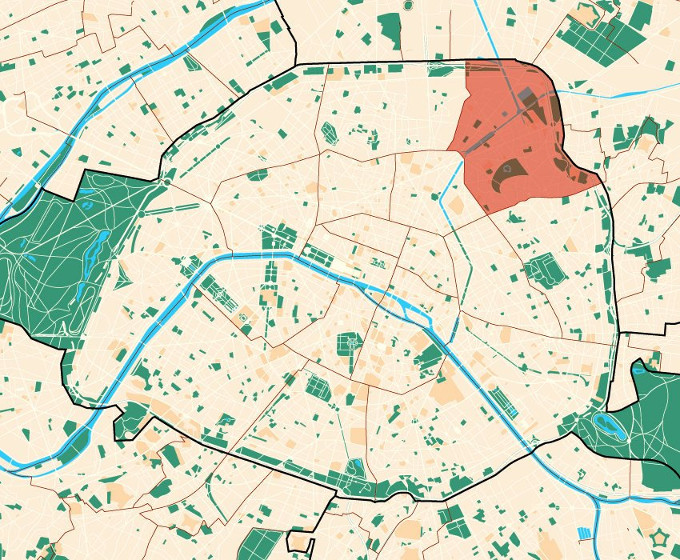
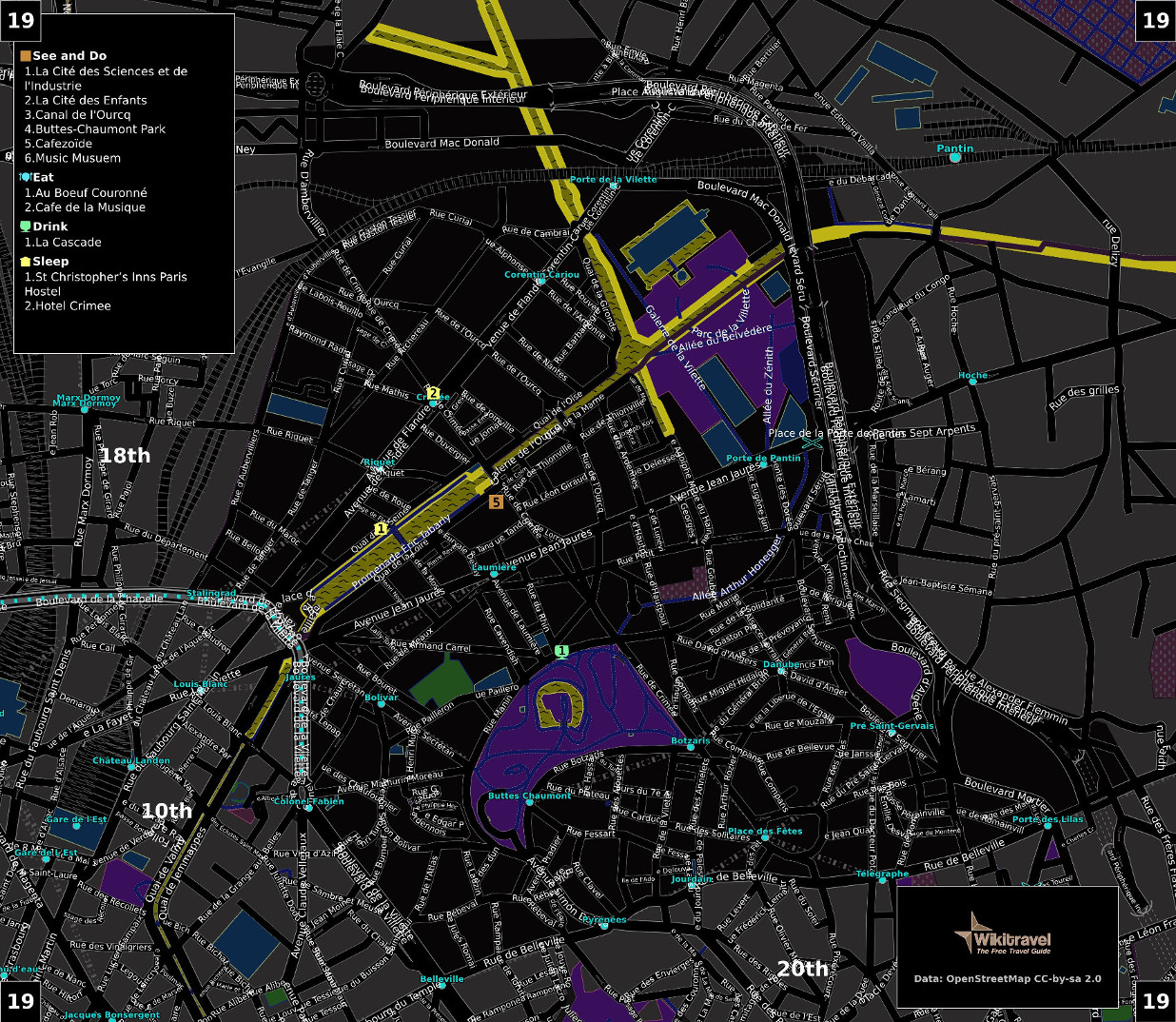
Introduction: Situated on the Right Bank of the River Seine, it is crossed by two canals, the Canal Saint-Denis and the Canal de l'Ourcq, which meet near the Parc de la Villette.
The 19th arrondissement includes two public parks: the Parc des Buttes Chaumont, located on a hill, and the Parc de la Villette, which is home to both the Cité des Sciences et de l'Industrie, a museum and exhibition centre, and the Conservatoire de Paris, one of the most renowned music schools in Europe and part of the Cité de la Musique.The Parc des Buttes Chaumont. A residential neighborhood with many ethnic restaurants and shops. Parc de la Villette is located here with its Cité des Sciences et de l'Industrie museum and cultural center.
In the World of Darkness things have taken a decided turn for the worst here. The police have decided only major fires and or riots are worth showing up for here. What police do work here are under the thumb of several Anarchs that live in the area. It is not unheard of for deaths to happen here, and never be reported. Unlike other areas of Paris, people are slowly leaving the 19th. Many empty buildings and shop fronts mark it's streets.
There are several underground clubs here, and one Settite Temple. It is also common to find the Dark Freedom pack here, looking to recruit or hunt Anarchs...depending on which one amuses them more each night.
- -- :Parc des Buttes Chaumont
- -- :Parc de la Villette
- -- :Parc de la Butte-du-Chapeau-Rouge
- -- :The Cent Quatre arts centre
- -- :Psalm 69
- -- :
- -- :
- -- :
- -- :
- -- :
20th Arrondissement: Belleville, Lachaise
[[]]
Introduction: Belleville, Ménilmontant and the Père-Lachaise cemetery. Although traditionally working class, this outlying residential area is slowly becoming yuppified due to its affordable prices and its popularity among artists and creative types. Ethnic shops, culture and restaurants abound.
- -- :
- -- :
- -- :
- -- :
- -- :
- -- :
- -- :
- -- :
- -- :
- -- :
Below Paris
- -- l'Ossuaire Municipal de Paris -- The Catacombs of Paris.
- -- Carrières de Paris -- The quarries or mines of Paris.
- -- Hakima Hamoun - Endless Night Vampire Ball - Caves Saint Sabin - 21/12/2012 --
Arenas
Attractions
- -- La Tour Eiffel (Eiffel Tower) -- is an iron lattice tower located on the Champ de Mars in Paris.
- -- Mysteries of Paris --
Bars and Clubs
- -- Le Boeuf sur le Toit
- -- Les Ruines
- -- Psalm 69
Cemeteries
City Government
- -- Detective Antoine Pelletier -- Paris Police Archives.
- -- Rainier Paget (1865 - 1937)
Citizens of the City
- -- Léo Bonnay -- French male model (dating: Marguerite Pascal)
- -- Marguerite Pascal - French female actress (dating: Léo Bonnay)
Crime
Cults
- -- L'oracle des Innocents -- {Defunct} / {Active from 1868 - 1890}
Current Events
Fortifications
Galleries
- -- Musée du Louvre (The Louvre) -- is one of the world's largest museums and a historic monument.
Holy Ground
Hospitals
Hotels & Hostels
Landmarks
- -- Place Vendôme: is a square in the 1st arrondissement of Paris, France, located to the north of the Tuileries Gardens and east of the Église de la Madeleine. It is the starting point of the Rue de la Paix. It is famous for its deluxe hotels such as Hôtel Ritz, Hôtel de Rambouillet, The Westin Paris – Vendôme, Hôtel de Toulouse, Hôtel du Petit-Bourbon, Hôtel Meurice, and the Hôtel Regina. Located within the 1st Arrondissement
- --
- --
- --
- --
- --
- --
- --
- --
- --
- --
- --
- --
- --
- -- Palace of Versailles
Law Enforcement
Law enforcement in France has a long history dating back to AD 570, when night watch systems were commonplace. Policing is centralized at the national level. At the beginning of the 21st century, legislation allowed local governments to hire their own police officers which are called the "police municipale".
There are two national police forces called "Police nationale" and "Gendarmerie nationale". The Prefecture of Police of Paris provides policing services directly to Paris as a subdivision of France's Ministry of the Interior. Within these national forces only certain designated police officers have the power to conduct criminal investigations which are supervised by investigative magistrates.
Maps
Market Places
Monasteries
Monuments
Multinational Corporations
Museums
- -- The Louvre
Neighborhoods
Opera Houses
- -- Palais Garnier -- The Opera House of Paris. {Now used primarily for the purposes of ballet.}
- -- Opera Bastille --
Parks
Private Residences
Restaurants
Ruins
Schools
Shops
Etres Surnaturels de Paris
Theaters
Transportation
Paris is a major rail, highway, and air transport hub. The Syndicat des transports d'Île-de-France (STIF), formerly Syndicat des transports parisiens (STP) oversees the transit network in the region. The syndicate coordinates public transport and contracts it out to the RATP (operating 654 bus lines, the Métro, three tramway lines, and sections of the RER), the SNCF (operating suburban rails, one tramway line and the other sections of the RER) and the Optile consortium of private operators managing 1,070 minor bus lines.
The city's subway system, the Métro, was opened in 1900 and is the most widely used Transport system within the city proper, carrying about 9 million passengers daily. It comprises 303 stations (385 stops) connected by 220 km (136.7 mi) of rails, and 16 lines, identified by numbers from 1 to 14, with two minor lines, 3bis and 7bis. An additional express network, the RER, with five lines (A, B, C, D, & E), connects to more-distant parts of the urban area, with 257 stops and 587 km (365 mi) of rails. Over €26.5 billion will be invested over the next 15 years to extend the Métro network into the suburbs. In addition, the Paris region is served by a light rail network of six lines, the tramway: Line T1 runs from Asnières-Gennevilliers to Noisy-le-Sec, line T2 runs from Pont de Bezons to Porte de Versailles, line T3a runs from Pont du Garigliano to Porte de Vincennes, line T3b runs from Porte de Vincennes to Porte de la Chapelle, line T5 runs from Saint-Denis to Garges-Sarcelles, all of which are operated by the Régie Autonome des Transports Parisiens, and line T4 runs from Bondy RER to Aulnay-sous-Bois, which is operated by the state rail carrier SNCF. Six new light rail lines are currently in various stages of development.
Paris is a central hub of the national rail network. The six major railway stations — Gare du Nord, Gare de l'Est, Gare de Lyon, Gare d'Austerlitz, Gare Montparnasse, Gare Saint-Lazare — and a minor one — Gare de Bercy — are connected to three networks: The TGV serving four High-speed rail lines, the normal speed Corail trains, and the suburban rails (Transilien).
Four international airports, Paris-Charles de Gaulle, Paris-Orly, Paris-Le Bourget and Beauvais-Tillé, serve the city. The two major airports are Orly Airport, which is south of Paris; and the Paris-Charles de Gaulle Airport, in Roissy-en-France, which is one of the busiest in the world and is the hub for the unofficial flag carrier Air France.
The city is also the most important hub of France's motorway network, and is surrounded by three orbital freeways: the Périphérique, which follows the approximate path of 19th-century fortifications around Paris, the A86 motorway in the inner suburbs, and finally the Francilienne motorway in the outer suburbs. Paris has an extensive road network with over 2,000 km (1,243 mi) of highways and motorways. By road, Brussels can be reached in three hours, Frankfurt in six hours and Barcelona in 12 hours. By train, London is now just two hours and 15 minutes away.
There are 440 km (270 mi) of cycle paths and routes in Paris. These include piste cyclable (bike lanes separated from other traffic by physical barriers such as a kerb) and bande cyclable (a bicycle lane denoted by a painted path on the road). Some 29 km (18 mi) of specially marked bus lanes are free to be used by cyclists, with a protective barrier protecting against encroachments from vehicles. Cyclists have also been given the right to ride in both directions on certain one-way streets. Paris offers a bike sharing system called Vélib' with more than 20,000 public bicycles distributed at 1,800 parking stations, which can be rented for short and medium distances including one way trips.
The Paris region is the most active water transport area in France, with most of the cargo handled by Ports of Paris in facilities located around Paris. The Loire, Rhine, Rhone, Meuse and Scheldt rivers can be reached by canals connecting with the Seine, which include the Canal Saint-Martin, Canal Saint-Denis, and the Canal de l'Ourcq.
Airports
History: Paris had its first airport in the fields of Issy-les-Moulineaux (just to the southern limits of Paris by its Seine river's Left Bank) from the first aviation trials of 1908. Aviation became a serious mode of transport during the course of the first world war, which in 1915 led to the installation of a larger and more permanent runway installation near the town of Le Bourget to the north of Paris. A yet larger airport to the south of the Capital, Orly International Airport, began welcoming flights from 1945, and yet another airport to the north of the City, Roissy-Charles-de-Gaulle, opened its gates from 1974.
Recently: Today the former airfields of Issy-les-Moulineaux have become a Heliport annex of Paris, and Le Bourget an airfield reserved for smaller aircraft. Roissy-Charles-de-Gaulle takes the majority of international flights to and from Paris, and Orly is a host to mostly domestic and European airline companies.
- -- Aéroport Paris–Charles de Gaulle: Paris Charles de Gaulle Airport (English), also known as Roissy Airport (or just Roissy in French), is one of the world's principal aviation centers, as well as France's largest airport. It is named after Charles de Gaulle (1890–1970), leader of the Free French Forces and founder of the French Fifth Republic. It is located within portions of several communes, 25 km (16 mi) to the northeast of Paris. The airport serves as the principal hub for Air France.
- -- Aéroport de Paris-Orly: Paris Orly Airport (English) is an international airport located partially in Orly and partially in Villeneuve-le-Roi, 7 NM (13 km; 8.1 mi) south[2] of Paris, France. It has flights to cities in Europe, the Middle East, Africa, the Caribbean, North America and Southeast Asia. (Albertine Perrot)
- -- Aéroport de Paris-Le Bourget: Paris–Le Bourget Airport (English) is an airport located at Le Bourget, in the districts of Bonneuil-en-France and Dugny, 6 NM (11 km; 6.9 mi) north-northeast of Paris, France. It is now used only for general aviation (business aviation) and air shows, most notably the Paris Air Show. (Morcant)
- -- Paris-Issy-les-Moulineaux Heliport -- (privately owned) -- Located within the 15th arrondissement.
Cycling in Paris
Métro de Paris
Montmartre funicular
Paris Bus
Railways
Réseau Express Régional
Transiliens
Historically: Paris's first embarcadère train station, the predecessor to the gare Saint-Lazare, appeared from 1837 as a home for the novelty Paris-à-Saint-Germain local line. Over the next ten years France's developing rail network would give Paris five (including the Saint-Lazare station) national railway stations and two suburban lines, and from 1848 Paris would become the designated centre of an Étoile (star) spider-web of rail with reaches to, and through, all of France's borders. This pattern is still very visible in France's modern railway map.
Currently: As far as national and European destinations are concerned, rail transport is beginning to outdistance air travel in both travel time and efficiency. The still-developing SNCF's TGV (Train à Grande Vitesse) network, since its birth in 1981, brings France's most southerly city Marseille only three hours from the capital. A train similar to the TGV, the Eurostar, has been connecting Paris to central London through since 1994 (travel time is two hours and fifteen minutes), and in the opposite direction, the Thalys line connects Paris to Brussels (travel time is one hour and twenty-two minutes) with up to 26 departures per day, Paris is connected to Amsterdam (travel time is three hours and eighteen minutes) with up to 10 departures per day, and Paris is connect to Cologne (travel time is three hours and fourteen minutes) with up to 6 departures per day.
Vampires of the City
The Legacy of Caine: The Traditions
"The Traditions are written for memory in English and for mood purpose in French."
La Mascarade / The Masquerade
Vous ne révélerez pas votre vraie nature à ceux qui ne sont pas de notre Sang. Le faire revient à renoncer à
votre Sang.
Thou shall not reveal thy true nature to those not of the Blood. Doing such shall renounce thy claims of Blood.
Le Domaine / The Domain
Votre Domaine est le vôtre uniquement. Tous vous y doivent le respect. Personne ne peut défier votre parole dans votre Domaine.
Thy domain is thy own concern. All others owe thee respect while in it. None may challenge thy word while in thy domain.
Note that this Tradition is still respected in France, but the Domains are usually reserved to high-status Kindred, like the Primogen and the Ducs. Of course, one can invoke this Tradition when defending her Haven...
La Progéniture / The Progeny
Vous n'Infanterez qu'avec la permission de votre Ancien. Si vous Infantez sans l'autorisation de votre Ancien,
vous et votre Infant serez détruits.
Thou shall only Sire another with the permission of thine elder. If you createst another without thine Elder's leave, both thou
and thy Progeny shall be slain.
L'Instruction / The Accounting
Ceux et Celles que vous créez sont vos Infants. Jusqu'à ce que vos Infants soient libérés, vous les commanderez en toutes choses.
Leurs péchés seront aussi les vôtres, et vous en subirez les conséquences.
Those thou create are thine own children. Until thy Progeny shall be Released, thou shall command them in all things. Their sins
are thine to endure.
Hospitalité / Hospitality
Honorez le Domaine de l'autre. Quand vous entrerez dans une cité étrangère, vous vous présenterez à celui qui y règne.
Sans son acceptation, vous n'êtes rien.
Honor one another's domain. When thou comest to a foreign city, thou shall present thyself to the one who ruleth there.
Without the word of acceptance, thou art nothing.
Destruction / Destruction
Il vous est interdit de détruire l'un de vos Frères ou l'une de vos Soeurs de Sang.
Le Droit de Destruction n'appartient qu'à votre Ancien. Seul l'Ancien parmi les Anciens peut appeler une Chasse de Sang.
Thou art forbidden to destroy another of thy kind. The right of destruction belongeth only to thine Elder.
Only the Eldest among thee shall call the Blood Hunt.
The Legacy of Villon: The Edicts
"The Edicts are written in English for understanding, and in French for mood purpose."
L'Art / The Art
Vous ne devrez ni voler, ni détruire, ni altérer un Objet d'Art sans l'Autorisation de l'Ancien parmi les Anciens. Aucun Objet
d'Art ne doit sortir du Territoire de France sans l'Autorisation de l'Ancien parmi les Anciens.
You must not steal, destroy, or alter an Object of Art without the Authorization of the Eldest among you.
No Object of Art is to exit the domain of France without the Authorization of the Eldest among you.
L'Elysée / The Elysium
Les Lieux protégé par l'Elysée ne pourront être le théatre de violence, ni de la Chasse. Provoquer la violence ou Chasser dans
dans l'Elysée sans l'Autorisation de l'Ancien parmi les Anciens est passible d'une Chasse de Sang. Par mesure de sécurité, l'accès
de certains Elysées sera réglementé.
Grounds protected by the Elysium will not be sullied by violence of hunt. Provoke violence or hunting in an Elysium without
the authorization of the Eldest among you can be punished by the Blood Hunt. For security reasons, the access to some
Elysiums will be limited.
L'Ordre / Order
L'ordre doit être garanti par le Prince, qui s'approprie donc de manière exclusive les moyens d'assurer l'ordre et le bien-être de
la Famille comme du Bétail. Il est par consécquent formellement interdit d'influencer les forces de polices et les forces armées.
Les Masques et les Veilleurs, étant les representants du Prince, ne sont pas soumis à cet Edit.
Order is to be eguarranteed by the Prince, who thus gather exclusively for himself the means to warrant the order and wellbeing
of Kindred and Kine. Thus it is strictly forbidden to influence the police and army forces.
The Masques and the Veilleurs, being the representants of the Prince, are not submitted to this Edict.
La Magye / The Magick
Il est formellement interdit de pratiquer des Rituels Magiques en présence d'un Mage, comme il est formellement interdit d'avoir
des contacts avec eux. Leur guerre d'Ascensíon n'est pas la nôtre. L'acceptation du Clan Tremere à Paris sera subordonnée à
la conduite de leur membres.
Les Veilleurs ne sont pas soumis à cet Edit.
Praticing magic rituals in presence of a Mage is strictly forbidden, as is any contact with them. Their Ascensíon war is not
our own. The acceptation of the Clan Tremere in Paris is conditioned by the behaviour of their members.
The Veilleurs are not submitted to this Edict.
Diablerie / Diablerie
La Diablerie est un acte infâme indigne de notre Condition. Tout Caïnite convaincu de Diablerie sera passible d'une Chasse de Sang,
et ce, quel qu'ait été le Calice, ou l'endroit du crime.
Diablerie is an atrocious action under our condition. Any Kindred guilty of Diablerie can be Blood Hunted, no matter who was
the victim and where it happened.
L'Amaranthe / The Amaranth
Ceux qui se seront montré particulièrement indigne de leur Sang pourront voir leur Sang arraché par l'Amaranthe. Seuls ceux qui
auront été dignes des Traditions et Edits de Paris pourront se voir peut-être accordé par l'Ancien parmis les Anciens, l'Amaranthe.
Those who acted in ways unworthy of their Blood can be subject to the Amaranth. Those who acted in ways worthy of their Blood and
of the Traditions and Edicts can be given the right of Amaranth by the Eldest among you.
The Enforcers of Villon
- -- The Masques
- -- The Veilleurs
Les Droits Coutumiers: The Customary Laws
These rights are not written in stone, but have been respected, unless exception is asked for. Thus, there is no official text, and the Prince has the final say if a Customary Law is to be applied or not, and how it is to be applied. For example, in March-May 1997, Vanessa was killed and her murderer was not found. Villon then gave the Brujah the right to Embrace Viktor... Who almost as soon as killed the Ventrue Leonard. The Ventrue asked, then, the right to replace the deceased Ventrue... But Villon decided that, as the Ventrue anyway wanted Leonard dead, the Ventrue Anarch Charles Henri de Montex would be granted this right of replacement...
- If a member of a clan is destroyed in an illegal way (i.e.: Killed by another Kindred, or by Sabbat, etc.), the said Clan is generally granted the right to Embrace another Progeny to replace the dead Kindred.
- Diablerie of Sabbat is tolerated as long as Villon accepts it before it happens.
- La Sentence de Mort is a kind of punishment prized by Villon. Instead of ordering a Blood Hunt on a Kindred, he simply condemn her to death. This death sentence is applicable whenever Villon sees it fit. In practice, Villon uses it to condemn Kindred, who decided either to exile themselves from France, or see it as a first warning. Villon uses this right to warn potential offenders without ordering a full Blood Hunt, and so makes it possible for the offender to redeem herself, which is not possible when under the Blood Hunt. Should the offender repeat his mistake, Villon simply order someone to apply the Sentence. As the Sentence was already ordered, there is little thing someone can tell to defend the offender... Traditionalists sees it as a violation of the spirit of the Lextalionis. Villon answers in a typically Anarch fashion that he doesn't care, but he is quick to add that should the opponent offend the Traditions in the slightest way, he will honor her with a full Blood Hunt, instead of the simple Sentence de Mort...
Note: This removes the possibility of the manipulation of the Prince by intriguing situation when your enemy must breach the Masquerade, or when the proofs seems too much real or appear the the convenient moment... Villon is most unforgiving for Kindred using this kind of manipulation.
Vampire Factions in Paris
Effect of the Toreador Hegemony on Status
Status, France Paris 0 Unknown Unknown * Neonate Neonate ** Ancilla Ancilla *** Elder Elder, Prévôt **** Elder Primogen, Senechal, Légat ***** Duc,Duchesse Marquis, Marquise ***** * Prince of Paris
The Kindred society of Paris, is divided in five classes. The Kindred of France are within the Parisian system, but are less considered.
The first is limited in access to the Clan of the Rose, the Toreador. They are the 'royal' bloodline of France. The only one able, by Blood, to become real Princes in France (Remember: All french Princes are Marquis). The Toreador are the only one able to reach a Status of 6.
The second class is the Noble: The any Clan, Bloodline or sect recognizing the hegemony of the Toreador and of the Camarilla can become noble if they are considered worthy enough (i.e. if they have enough power to threaten the Prince, or win enough Toreador Prestige, like the Daughters of Cacophony). They have the right to be represented by their leader which will be called Duc or Duchesse. Their Status is limited to 5.
In the same way, the Marquis and Marquises are limited to five. In their city, the Status works as explained in the Vampire Sourcebook. Note that anyone reaching the Status of 5 is offered a seat in the Grand Cour. Someone reaching a status of four is considered as powerful as any Primogen of France, and can take a seat in any Primogen in the city where she decides to move (if her powerbase works in that city, too...).
The third are the non-Noble, also called the Peuple (The People), who are any Clan, Bloodline or Sect as explained above, but without power or prestige enough to become Noble. Their status is limited to 3. Only those being Primogen in any Camarilla City will be considered as with a Status of 4.
The fourth are the Gueux, also called the Bâtards. They have no Clan, nor Lineage, and are, thus, not really recognized by the Kindred society (which sees a lot of importance in the whole Generation/Bloodline story!). Most of them are true Caitiffs, some others are Autarkis. In the contrary to other more conservative European cities, Caitiffs are accepted, but have no power, and are, most of the time, not even acknowledged. The truth is that the Gueux are the lowest 'citizens' of the Kindred society, and that the rest of the Kindred society likes it to have people considered as inferior. Note that some Clans are represented in this category: Assamites, as well as Ravnos are considered as Gueux because of their enmity with the Toreador, even if their Blood makes them somewhat superior (but more dangerous, and thus, less liked, if they are still more respected) to the Caitiff. Their status is limited to 2. Note that most (if not all) Anarchs, but their leader, fall in this category, as they are considered immature in a Kindred viewpoint! Note, too, that Caitiff can have Status, but has a permanent malus of 1 because of the Clan prejudice. Thus, a Caitiff whose presence is accepted in Paris have a legal Status of 1. But for any interaction, the Caitiff has a malus of 1 and thus is considered as having a Status of 0.
The Fifth are the Kindred under a Blood Hunt, or from enemy Clans or Sects: The Sabbat Antitribu, the Lasombra and the Tzimisce, The Baali (for those who know of their existence), etc. The only status they have is their Generation (that can attract Legal Diabolist wannabes!).
Note that the limitation also applies to the other Background traits! If a Non-Noble Kindred happens to fall in the wrong side of the Toreador, and is discovered to have a Resources ***** Background, the Toreador will work to decrease it to acceptable limits (so, 3 for most non-Noble Clan Kindred -- it's equal to the Status limitation). This part isn't official, and is not automatic. But someone attracting the attention of the Clan (in the wrong way) will probably be victim of Background changes...
This non-official limitation, part of the Toreador Hegemony, is the principal subject of intrigues and discussion within the Camarilla of Paris, and with the Anarchs, who believe nothing so stupid as Bloodline should limit one's power. But no one have the power to remove this non-written law, but still, they try...
The Noble Clans
Brujah
- -- The History of the Brujah in Paris
- -- Germaine -- Brujah Anathema from Paris.
Daughters of Cacophony
Gangrel
Followers of Set
La Belle Rose
Tremere
Chantry of Saint Louis
Chantry of Nonsis
The Chantry of Nonsis is located on the Avenue Mozart.
- -- Laureen d'Coventri
- -- Tania Caboche -- Right Hand of the Regent.
- -- Frederick Delagny
- -- Eloise Garebaldi
- -- Ruta Authran Rutell
Chantry of Champs Nu Marne
- -- Laurent Vestagus
- -- Jaslen Dreseens
- -- Braaga Urss -- Gargoyle butler
Ventrue
The Low or Unwelcome Clans
Assamites
- -- The Assamite History of Paris
- -- Fakir --
Batards or Caitiff
- -- Marc Livingston -- American Caitiff (deceased: 2040 or 2041)
- --
Giovanni
Lasombra antitribu
- -- Francesca -- 5th Generation.
- -- Tania Thomson -- 6th Generation.
Malkavians
Nosferatu
The Gargoyles of Paris
Guests of the Parisian Court
- -- Natasha Karaljk Scheinberg -- Tremere prophetess
- -- Czere Ubireg -- Warlock guardian of the Masquerade.
- -- Vespa -- The Velvet Serpent {Visitor to Paris}
Bloodlines
- -- Isa Mac Aba -- Oneiros
- -- Charlotte Dunkle -- True Brujah neonate from {Dresden}.
Tal'mehe'Ra
- -- Noor Samara
Paris - A Perspective
Ghouls of the City of Lights
The Ghosts of Paris
- -- L'Inconnue de la Seine -- L'Inconnue de la Seine (French for "The Unknown Woman of the Seine") was an unidentified young woman whose putative death mask became a popular fixture on the walls of artists' homes after 1900. Her visage inspired numerous literary works. In the United States, the mask is also known as "La Belle Italienne".
- -- Les Craintes vides de la Nuit -- A circle of Parisian Stripling nigh-terrors.
The Puppet Masters of Paris
Stories set within the City of Lights
- -- Tous les enfants perdus -- Story from 3/1/16 -
Websites
http://vampirerpg.free.fr/Genealogy/
https://augias.org/pbn/pbn_exe2.htm
https://en.wikipedia.org/wiki/The_Collection_(TV_series) -- Post W.W.II French noir
